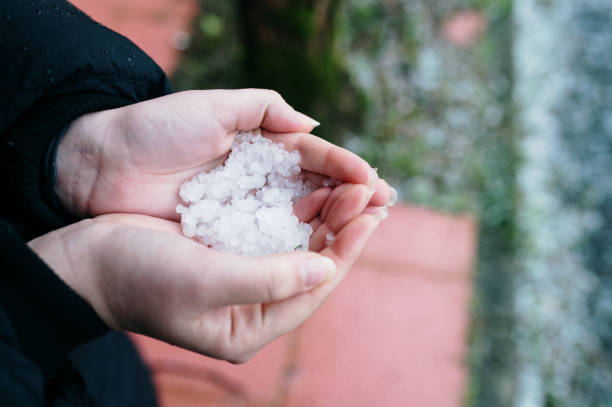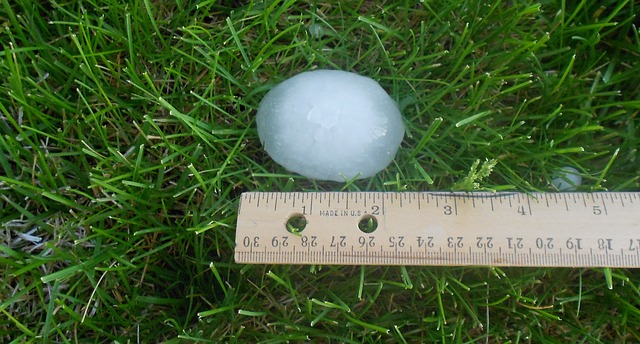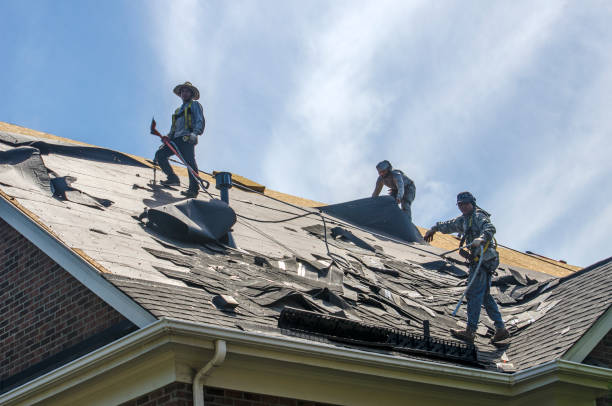Hailstorms can cause significant property and roof damage in Denver, Colorado. Knowing what to look for after a hailstorm is essential for your property, whether you have asphalt shingles or metal roofing.
Below, Peak to Peak Roofing offers advice to help you know what to check for after a damaging storm and how to safeguard your roof. Large hail can cause shingle damage, so it’s essential to be prepared.
Ready to fortify your home against the elements? Peak to Peak Roofing is here to help!
How to Inspect Your Roof for Hail Damage

To ensure your roof is in good condition after a hailstorm, it’s essential to inspect it thoroughly. Here are some steps you can take to check for hail damage on your roof:
Start by Visually Examining the Roof for Dents, Cracks, or Missing Shingles Caused by Hail
From the ground, take a close look at your roof and look for any obvious signs of hailstorm damage. Pay attention to any dents or cracks caused by hailstones. Look out for dented or cracked shingles, as well as any areas where the shingles may be completely missing. This is important for a roof hail damage inspection, especially after a storm. It helps identify any potential roof damage or storm damage that needs to be addressed. Hailstones can leave behind these telltale signs of impact on roof shingles, indicating potential damage.
Check for Granule Loss on Asphalt Shingles, Indicating Potential Hail Damage
Granule-coated asphalt shingles have an outer layer that shields them from hail storm-related roof damage. It is important to conduct a roof hail damage inspection after a hail storm to assess any potential roof damage. Hail can cause roof damage by loosening or dislodging granules from the shingles, resulting in storm damage. To check for hail damage and roof inspection, inspect your gutters and downspouts for an accumulation of granules after a hail storm. You may also notice bare spots or discoloration on the shingle surface where the hail-damaged roof granules have been removed due to a hail storm.
Conduct a Thorough Interior Inspection for Water Stains or Leaks That may have Resulted from Hail Damage
Hailstorms can sometimes cause hidden damage that isn’t immediately apparent from outside. Go up to your attic and carefully check the walls and ceiling for any water stains or indications of hail storm leakage. These could indicate that your roof sustained damage during the hailstorm. Keep an eye out for dampness, musty odors, and any signs of damage caused by a hail storm.
Consider Hiring a Professional Roofer if You’re Unsure About Conducting the Inspection Yourself
If you’re not comfortable climbing onto your roof or if you’re uncertain about what to look for, it’s best to call in a professional roofer who specializes in hail damage roof inspections. They have the expertise and experience necessary to identify even subtle signs of damage that might go unnoticed by an untrained eye. A professional inspection can provide you with peace of mind and ensure any necessary repairs are addressed promptly.
Visual Guide: What Hail Damage Looks Like on a Roof
Circular or Irregular-Shaped Dents on Metal Surfaces
When checking for hail damage on a roof, one of the key things to look out for is circular or irregular-shaped dents on metal surfaces. The impact of hailstones during a hailstorm is what caused these dents. The size of the hailstones can vary, ranging from small-sized hail to large-sized hail, depending on the severity of the storm. So, if you have a metal roof, make sure to inspect it closely for any signs of these dents.
Shingles with Bruising, Tears, or Exposed Fiberglass Matting
Another way to identify hail damage is by examining your shingles. It’s likely that hail damage has occurred if you see shingles with bruising, tears, or exposed fiberglass matting. Hailstones can leave visible marks and indentations on shingles, which may appear as spots or areas where the granules have been knocked off. These damaged areas can weaken the integrity of your roof and lead to further issues if not addressed promptly.
Split or Cracked Wood Shakes and Tiles
For roofs made of wood shakes or tiles, split or cracked pieces are clear indicators of severe hail damage. When large hail hits these types of roofing materials with force, it can cause them to split open or crack. This type of damage is more noticeable compared to other roofing materials and should be addressed immediately to prevent leaks and structural problems in your home.
Inspecting your roof for signs of hail damage is essential after experiencing a severe storm in Denver, Colorado, or any other area prone to hailstorms. By being aware of what to look for when checking your roof’s condition after a hailstorm has passed through, you can take the necessary action quickly and avoid potential long-term issues.
To summarize:
- Circular or irregular-shaped dents on metal surfaces indicate hail damage.
- Shingles with bruising, tears, or exposed fiberglass matting are signs of hail damage.
- Split or cracked wood shakes and tiles are indicators of severe hail damage.
Remember, it’s crucial to address any hail damage promptly to prevent further deterioration and potential leaks in your roof. If you’re unsure about the extent of the damage or need assistance with repairs, consult a professional roofing contractor who can provide expert guidance and ensure the safety and integrity of your roof.
Assessing Hail Damage on Siding, Gutters, and Downspouts
Inspect the Siding for Cracks, Holes, Chipped Paint, or Dents Caused by Large-Sized Hailstones
When checking for hail damage on your roof, it’s important not to overlook your home’s siding. Large-sized hailstones can cause significant damage to the exterior surfaces of your house.
Take a close look at the siding and keep an eye out for cracks, holes, chipped paint, or dents. These are all indications that hail has impacted your siding.
- Pros: Identifying hail damage on siding allows you to address any necessary repairs promptly.
- Cons: Damaged siding can compromise the integrity of your home’s structure if left unattended.
Check Gutters and Downspouts for Dings and Dents, as They can Indicate Potential Roof Damage
Gutters and downspouts play a crucial role in diverting water away from your roof and foundation. When inspecting for hail damage, pay attention to these components as well. Look closely for any dings or dents along the gutters and downspouts. These might be signs of potential hail damage to the roof.
- Key Information: Damaged gutters and downspouts may lead to water leaks and further issues if not addressed promptly.
- Examples: If you notice dented gutters or downspouts after a severe storm in Denver, Colorado, it’s essential to have them inspected by a professional contractor.
Look Out for Displaced Granules in Gutters, as It May Suggest Roof Shingle Deterioration Due to Hail
Shingle deterioration is one typical form of hail damage to roofs. To assess this type of damage accurately, direct your attention towards the gutters. Keep an eye out for displaced granules accumulating in the gutter system. This can be a sign that the hail has caused the protective layer of your shingles to deteriorate.
- Examples: If you find an excessive amount of granules in your gutters after a hailstorm, it’s advisable to have a roofing contractor assess the condition of your roof.
- Key Information: Shingle deterioration can lead to leaks and other issues if not addressed promptly.
By thoroughly inspecting your home’s siding, gutters, and downspouts, you can identify potential hail damage and take appropriate action. Remember that promptly addressing any damage is crucial to preventing further issues. If you notice signs of hail damage on these exterior surfaces, it’s recommended to consult with a professional contractor who specializes in storm-related repairs.
Factors Affecting Hail Damage Severity
Size of the Hailstones

The size of the hailstones that pelt your roof can have a significant impact on the severity of the damage inflicted. Larger hailstones tend to cause more extensive and noticeable damage compared to smaller ones. When hailstones are bigger in diameter, they carry more weight and possess more kinetic energy when they hit your roof. This increased force can lead to dents, cracks, or even punctures in roofing materials.
The Angle at Which the Hail Falls
Believe it or not, the angle at which the hail falls can also influence the level of destruction it causes on your roof. When hail falls vertically from above, its force is distributed evenly across your roof’s surface area. However, if there are strong winds accompanying the hailstorm, they can cause the hailstones to fall at an angle. As a result, this angled impact concentrates its force on specific areas of your roof, potentially causing more concentrated damage.
Roofing Material’s Durability

Another crucial factor that determines how susceptible a roof is to hail damage is its material’s durability. Different roofing materials have varying levels of resilience. For example, asphalt shingles may be more susceptible to cracking or splitting under intense hailstorms compared to metal or tile roofs. It’s essential to consider the type of roofing material you have and its ability to withstand potential damage caused by various sizes and speeds of falling hail.
When assessing potential hail damage on your roof in Denver, Colorado (or any other location), considering these factors can help you gauge its severity accurately:
- Hail size: Take note of the diameter or approximate size of the largest hailstone you observe.
- Impact force: Assess how forcefully the hail struck your roof by examining any visible signs of denting or other forms of damage.
- Wind speeds: Consider whether strong winds accompany the hailstorm, as this can increase the force and velocity at which the hailstones hit your roof.
- Amount of hail: Evaluate the volume of hail that fell during the storm, as a greater quantity can lead to more significant damage.
- Roofing material type: Understand how durable your roofing material is and its susceptibility to different types of damage.
Considering these factors and conducting a thorough inspection, you can determine if your roof has sustained any hail damage and take appropriate action to address it. Remember that seeking professional assistance from a qualified roofing contractor is always advisable for an accurate assessment and necessary repairs.
Dealing with Insurance: Filing a Hail Damage Claim
After discovering hail damage on your roof, contacting your insurance company promptly is crucial. They need to be aware of the situation so that you can begin the process of filing a hail damage claim. This step is vital in ensuring that you receive proper compensation for the repairs needed.
Contacting Your Insurance Company
Once you’ve noticed roof-related damages caused by hailstorms, reach out to your insurance company as soon as possible. It’s important not to delay this step because some insurance policies have time limits for filing claims. By contacting them promptly, you can ensure that your claim is processed efficiently and avoid any potential complications.
Documenting the Damage
Before proceeding with the claim, make sure to document the hail damage thoroughly. Take photographs of all visible damage to your roof from various angles. These pictures will serve as evidence for your claim and help support your case when dealing with insurance adjusters.
Keep records of repair estimates provided by roofing professionals or contractors. These estimates will give an accurate assessment of the extent of the damage and help determine the costs involved in repairing or replacing your roof.
Understanding Your Policy Coverage and Deductible
Before filing a hail damage claim, it’s essential to understand your insurance policy’s coverage and deductible. Familiarize yourself with what is covered under your homeowners’ insurance policy regarding property damage caused by hailstorms.
Reviewing these details will give you a clear understanding of what expenses are eligible for reimbursement through your insurance company. Knowing your deductible amount will help you plan financially for any out-of-pocket expenses that may arise during the claims process.
The Insurance Claims Process
Once you’ve gathered all the necessary documentation and have a good understanding of your policy coverage, it’s time to initiate the claims process. Contacting an insurance adjuster assigned by your insurance company is usually the next step.
The adjuster will assess the hail damage to your roof and determine the extent of the repairs needed. They will also help you understand how your claim will be processed, including any required paperwork or additional information.
Tips for a Smooth Insurance Claim Experience
To ensure a smooth insurance claim experience, consider the following tips:
- Be proactive in reporting the damage promptly.
- Keep all communication with your insurance company in writing for documentation purposes.
- Follow up with your insurance adjuster regularly to stay informed about the progress of your claim.
- Be prepared to provide any additional information or documentation your insurance company requests.
Remember that each insurance company may have its own specific process and requirements when dealing with hail damage claims. It’s essential to familiarize yourself with these guidelines and follow them accordingly.
By being proactive, documenting the damages thoroughly, understanding your policy coverage, and following the necessary steps in filing a hail damage claim, you can increase your chances of receiving fair compensation for repairing or replacing your roof.
Addressing and Repairing Hail Damage
Hire a Professional Roofing Contractor

To properly assess the extent of hail damage on your roof, it is crucial to hire a professional roofing contractor. These experts have the knowledge and experience to accurately identify any issues caused by hailstorms. They will thoroughly inspect your roof for signs of damage, such as cracked or missing shingles, dented metal surfaces, or damaged flashing.
Promptly Address Leaks and Structural Issues
If you notice any leaks or structural issues resulting from hail damage, it is essential to address them promptly. Ignoring these problems can lead to further deterioration and costly repairs down the line. Leaks can cause water damage to your home’s interior and compromise its structural integrity. By addressing these issues promptly, you can mitigate further damage and protect your property.
Follow Proper Repair Procedures
When repairing hail damage on your roof, following the procedures professionals recommend is crucial. This may involve replacing damaged shingles or repairing dented metal surfaces. For asphalt shingle roofs, damaged shingles should be carefully removed and replaced with new ones that match the existing color and style.
Consider Contacting Your Insurance Company
If you live in an area prone to hailstorms like Denver, Colorado, consider contacting your insurance company after assessing the extent of the hail damage on your roof. They can guide you through the claims process and help cover the cost of repairs or even a full roof replacement if necessary.
Protect Other Components of Your Home
Hailstorms not only impact roofs but can also cause damage to other components of your home. Air conditioning units with exposed coils may suffer from bent fins due to large hailstones hitting them. Fiberglass mat-based materials used in various parts of homes may also become compromised during severe storms.
Regular Maintenance is Key
To prevent future hail damage or minimize its impact on your roof, regular maintenance is key. Keep trees trimmed to prevent branches from rubbing against the roof, which can cause damage during hailstorms. Regularly inspect your roof for any signs of wear and tear and address them promptly.
How Do You Check Hail Damage on a Roof?
Armed with the knowledge of how to inspect for hail damage, what it looks like, and the factors that affect its severity, you can confidently navigate the process of dealing with insurance claims and repairing any resulting damage. Remember, prevention is key. Regularly inspecting your roof and promptly addressing any issues will help safeguard your investment in the long run.
So, don’t wait for the next storm to hit before taking action. Take charge of your roof’s health and ensure its longevity by conducting regular checks for hail damage. By doing so, you’ll be able to catch potential problems early on and save yourself from costly repairs. Your roof is your home’s first defense against nature’s wrath, so ensure it remains strong and resilient.
Ready to protect your home from the unpredictable fury of hailstorms? Contact Peak to Peak Roofing today for expert roof inspections and repairs. Don’t wait until it’s too late! Your peace of mind begins with a sturdy roof.

